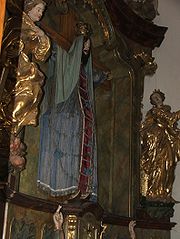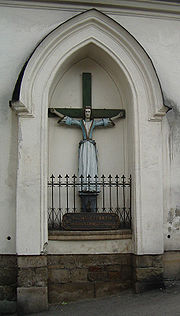
Saint Wilgefortis
Encyclopedia
Wilgefortis is a female saint
of popular religious imagination whose cult arose in the 14th century. Her name is thought by some to derive from the Old German "heilige Vartez" ("holy face"), a translation of the Italian "Volto Santo"; others believe it to derive from the Latin "virgo fortis" ("strong virgin"). In England her name was Uncumber, and in Dutch Ontkommer (where her name means escaper). In German lands she was known as Kümmernis (where her name means "grief" or "anxiety"). She was known as Liberata in Italy and Librada in Spain (where her name means "liberated"), and as Débarras in France (where her name means "riddance"). In places such as Sigüenza
, Spain, she was sometimes conflated with another Saint Liberata, the sister of Saint Marina of Aguas Santas
, whose feast was also celebrated on July 20. She was venerated by people seeking relief from tribulations, in particular by women who wished to be liberated ("disencumbered") from abusive husbands.
Art historians have argued that the origins of the cult can be found with the Volto Santo of Lucca, a large eleventh century carved wooden figure of Christ on the Cross (now replaced by a 13th century copy), bearded like a man, but dressed in a full-length tunic like a woman instead of the normal loin cloth familiar in the West. The theory is that when the composition was copied and brought north over the next 150 years, in small copies by pilgrims and dealers, this unfamiliar image led trouser-wearing Northerners to create a narrative to explain the androgynous icon.
According to the narrative, sometimes set in Portugal
, a teen-aged noblewoman named Wilgefortis had been promised in marriage by her father to a pagan king. To thwart the unwanted wedding, she had taken a vow of virginity, and prayed that she would be made repulsive. In answer to her prayers she sprouted a beard
, which ended the engagement. In anger, Wilgefortis's father had her crucified
.

 St Wilgefortis remained popular in the North until the end of the Gothic period; there is an especially attractive carving in the Henry VII Chapel of Westminster Abbey
St Wilgefortis remained popular in the North until the end of the Gothic period; there is an especially attractive carving in the Henry VII Chapel of Westminster Abbey
of a beautiful standing Wilgefortis holding a cross, with a very long beard.http://www.philipresheph.com/a424/study/picview.html She also appears, very lightly bearded, on the outside of a triptych
door by Hans Memling
http://www.philipresheph.com/a424/study/picview.html. She was decisively debunked during the late 16th century (after a period in the 15th and 16th centuries in which she was popular), and thereafter disappears from high art, although lingering well into the 20th century in more popular forms, especially in Bavaria
and Austria
, but also in northern France and Belgium.
She is often shown with a small fiddler at her feet, and with one shoe off. This derives from a legend, also attached to the Volto Santo of Lucca, of a silver shoe with which the statue had been clothed dropping spontaneously at the feet of a poor pilgrim (eventually pilgrims made off with so much of the Volto Santo that the present replacement was needed). In the Wilgefortis version the poor devotee became a fiddler, perhaps in the 13th century.
Saint
A saint is a holy person. In various religions, saints are people who are believed to have exceptional holiness.In Christian usage, "saint" refers to any believer who is "in Christ", and in whom Christ dwells, whether in heaven or in earth...
of popular religious imagination whose cult arose in the 14th century. Her name is thought by some to derive from the Old German "heilige Vartez" ("holy face"), a translation of the Italian "Volto Santo"; others believe it to derive from the Latin "virgo fortis" ("strong virgin"). In England her name was Uncumber, and in Dutch Ontkommer (where her name means escaper). In German lands she was known as Kümmernis (where her name means "grief" or "anxiety"). She was known as Liberata in Italy and Librada in Spain (where her name means "liberated"), and as Débarras in France (where her name means "riddance"). In places such as Sigüenza
Sigüenza
Sigüenza is a city in the province of Guadalajara in Spain.-History:The site of the ancient Segontia of the Celtiberian Arevaci, now called Villavieja , is half a league distant from the present Sigüenza...
, Spain, she was sometimes conflated with another Saint Liberata, the sister of Saint Marina of Aguas Santas
Marina of Aguas Santas
Saint Mariña of Augas Santas is a Spanish saint. She is a virgin martyr associated with the town of Augas Santas, in the province of Ourense. The story of her life as it has been preserved is a mixture of fact and fiction...
, whose feast was also celebrated on July 20. She was venerated by people seeking relief from tribulations, in particular by women who wished to be liberated ("disencumbered") from abusive husbands.
Art historians have argued that the origins of the cult can be found with the Volto Santo of Lucca, a large eleventh century carved wooden figure of Christ on the Cross (now replaced by a 13th century copy), bearded like a man, but dressed in a full-length tunic like a woman instead of the normal loin cloth familiar in the West. The theory is that when the composition was copied and brought north over the next 150 years, in small copies by pilgrims and dealers, this unfamiliar image led trouser-wearing Northerners to create a narrative to explain the androgynous icon.
According to the narrative, sometimes set in Portugal
Portugal
Portugal , officially the Portuguese Republic is a country situated in southwestern Europe on the Iberian Peninsula. Portugal is the westernmost country of Europe, and is bordered by the Atlantic Ocean to the West and South and by Spain to the North and East. The Atlantic archipelagos of the...
, a teen-aged noblewoman named Wilgefortis had been promised in marriage by her father to a pagan king. To thwart the unwanted wedding, she had taken a vow of virginity, and prayed that she would be made repulsive. In answer to her prayers she sprouted a beard
Beard
A beard is the collection of hair that grows on the chin, cheeks and neck of human beings. Usually, only pubescent or adult males are able to grow beards. However, women with hirsutism may develop a beard...
, which ended the engagement. In anger, Wilgefortis's father had her crucified
Crucifixion
Crucifixion is an ancient method of painful execution in which the condemned person is tied or nailed to a large wooden cross and left to hang until dead...
.


Westminster Abbey
The Collegiate Church of St Peter at Westminster, popularly known as Westminster Abbey, is a large, mainly Gothic church, in the City of Westminster, London, United Kingdom, located just to the west of the Palace of Westminster. It is the traditional place of coronation and burial site for English,...
of a beautiful standing Wilgefortis holding a cross, with a very long beard.http://www.philipresheph.com/a424/study/picview.html She also appears, very lightly bearded, on the outside of a triptych
Triptych
A triptych , from tri-= "three" + ptysso= "to fold") is a work of art which is divided into three sections, or three carved panels which are hinged together and can be folded shut or displayed open. It is therefore a type of polyptych, the term for all multi-panel works...
door by Hans Memling
Hans Memling
Hans Memling was a German-born Early Netherlandish painter.-Life and works:Born in Seligenstadt, near Frankfurt in the Middle Rhein region, it is believed that Memling served his apprenticeship at Mainz or Cologne, and later worked in the Netherlands under Rogier van der Weyden...
http://www.philipresheph.com/a424/study/picview.html. She was decisively debunked during the late 16th century (after a period in the 15th and 16th centuries in which she was popular), and thereafter disappears from high art, although lingering well into the 20th century in more popular forms, especially in Bavaria
Bavaria
Bavaria, formally the Free State of Bavaria is a state of Germany, located in the southeast of Germany. With an area of , it is the largest state by area, forming almost 20% of the total land area of Germany...
and Austria
Austria
Austria , officially the Republic of Austria , is a landlocked country of roughly 8.4 million people in Central Europe. It is bordered by the Czech Republic and Germany to the north, Slovakia and Hungary to the east, Slovenia and Italy to the south, and Switzerland and Liechtenstein to the...
, but also in northern France and Belgium.
She is often shown with a small fiddler at her feet, and with one shoe off. This derives from a legend, also attached to the Volto Santo of Lucca, of a silver shoe with which the statue had been clothed dropping spontaneously at the feet of a poor pilgrim (eventually pilgrims made off with so much of the Volto Santo that the present replacement was needed). In the Wilgefortis version the poor devotee became a fiddler, perhaps in the 13th century.

